Image To Image Translation
Image-to-image translation is the process of converting an image from one domain to another using deep learning techniques.
Papers and Code
Clarification as Supervision: Reinforcement Learning for Vision-Language Interfaces
Sep 30, 2025



Recent text-only models demonstrate remarkable mathematical reasoning capabilities. Extending these to visual domains requires vision-language models to translate images into text descriptions. However, current models, trained to produce captions for human readers, often omit the precise details that reasoning systems require. This creates an interface mismatch: reasoners often fail not due to reasoning limitations but because they lack access to critical visual information. We propose Adaptive-Clarification Reinforcement Learning (AC-RL), which teaches vision models what information reasoners need through interaction. Our key insight is that clarification requests during training reveal information gaps; by penalizing success that requires clarification, we create pressure for comprehensive initial captions that enable the reasoner to solve the problem in a single pass. AC-RL improves average accuracy by 4.4 points over pretrained baselines across seven visual mathematical reasoning benchmarks, and analysis shows it would cut clarification requests by up to 39% if those were allowed. By treating clarification as a form of implicit supervision, AC-RL demonstrates that vision-language interfaces can be effectively learned through interaction alone, without requiring explicit annotations.
RaceGAN: A Framework for Preserving Individuality while Converting Racial Information for Image-to-Image Translation
Sep 18, 2025Generative adversarial networks (GANs) have demonstrated significant progress in unpaired image-to-image translation in recent years for several applications. CycleGAN was the first to lead the way, although it was restricted to a pair of domains. StarGAN overcame this constraint by tackling image-to-image translation across various domains, although it was not able to map in-depth low-level style changes for these domains. Style mapping via reference-guided image synthesis has been made possible by the innovations of StarGANv2 and StyleGAN. However, these models do not maintain individuality and need an extra reference image in addition to the input. Our study aims to translate racial traits by means of multi-domain image-to-image translation. We present RaceGAN, a novel framework capable of mapping style codes over several domains during racial attribute translation while maintaining individuality and high level semantics without relying on a reference image. RaceGAN outperforms other models in translating racial features (i.e., Asian, White, and Black) when tested on Chicago Face Dataset. We also give quantitative findings utilizing InceptionReNetv2-based classification to demonstrate the effectiveness of our racial translation. Moreover, we investigate how well the model partitions the latent space into distinct clusters of faces for each ethnic group.
Time-Correlated Video Bridge Matching
Oct 14, 2025Diffusion models excel in noise-to-data generation tasks, providing a mapping from a Gaussian distribution to a more complex data distribution. However they struggle to model translations between complex distributions, limiting their effectiveness in data-to-data tasks. While Bridge Matching (BM) models address this by finding the translation between data distributions, their application to time-correlated data sequences remains unexplored. This is a critical limitation for video generation and manipulation tasks, where maintaining temporal coherence is particularly important. To address this gap, we propose Time-Correlated Video Bridge Matching (TCVBM), a framework that extends BM to time-correlated data sequences in the video domain. TCVBM explicitly models inter-sequence dependencies within the diffusion bridge, directly incorporating temporal correlations into the sampling process. We compare our approach to classical methods based on bridge matching and diffusion models for three video-related tasks: frame interpolation, image-to-video generation, and video super-resolution. TCVBM achieves superior performance across multiple quantitative metrics, demonstrating enhanced generation quality and reconstruction fidelity.
Training-Free Synthetic Data Generation with Dual IP-Adapter Guidance
Sep 26, 2025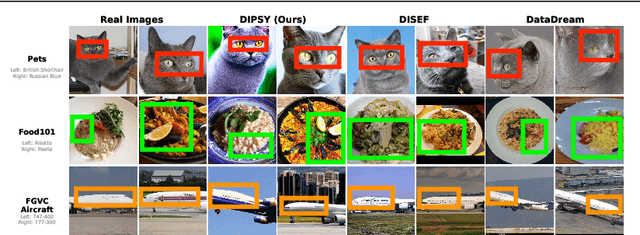



Few-shot image classification remains challenging due to the limited availability of labeled examples. Recent approaches have explored generating synthetic training data using text-to-image diffusion models, but often require extensive model fine-tuning or external information sources. We present a novel training-free approach, called DIPSY, that leverages IP-Adapter for image-to-image translation to generate highly discriminative synthetic images using only the available few-shot examples. DIPSY introduces three key innovations: (1) an extended classifier-free guidance scheme that enables independent control over positive and negative image conditioning; (2) a class similarity-based sampling strategy that identifies effective contrastive examples; and (3) a simple yet effective pipeline that requires no model fine-tuning or external captioning and filtering. Experiments across ten benchmark datasets demonstrate that our approach achieves state-of-the-art or comparable performance, while eliminating the need for generative model adaptation or reliance on external tools for caption generation and image filtering. Our results highlight the effectiveness of leveraging dual image prompting with positive-negative guidance for generating class-discriminative features, particularly for fine-grained classification tasks.
Transport Based Mean Flows for Generative Modeling
Sep 26, 2025



Flow-matching generative models have emerged as a powerful paradigm for continuous data generation, achieving state-of-the-art results across domains such as images, 3D shapes, and point clouds. Despite their success, these models suffer from slow inference due to the requirement of numerous sequential sampling steps. Recent work has sought to accelerate inference by reducing the number of sampling steps. In particular, Mean Flows offer a one-step generation approach that delivers substantial speedups while retaining strong generative performance. Yet, in many continuous domains, Mean Flows fail to faithfully approximate the behavior of the original multi-step flow-matching process. In this work, we address this limitation by incorporating optimal transport-based sampling strategies into the Mean Flow framework, enabling one-step generators that better preserve the fidelity and diversity of the original multi-step flow process. Experiments on controlled low-dimensional settings and on high-dimensional tasks such as image generation, image-to-image translation, and point cloud generation demonstrate that our approach achieves superior inference accuracy in one-step generative modeling.
Bidirectional Mammogram View Translation with Column-Aware and Implicit 3D Conditional Diffusion
Oct 06, 2025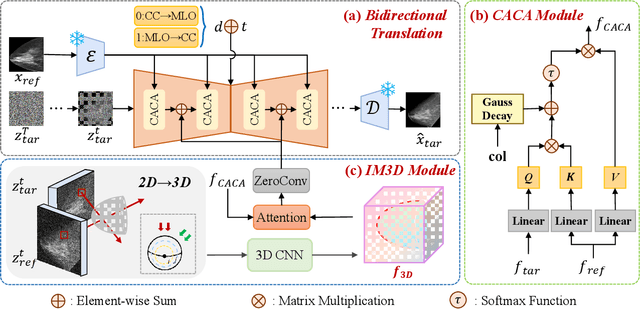
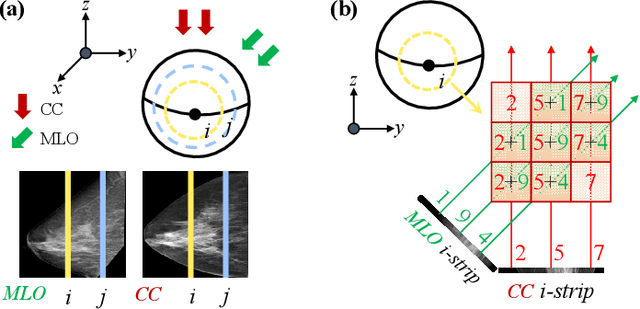
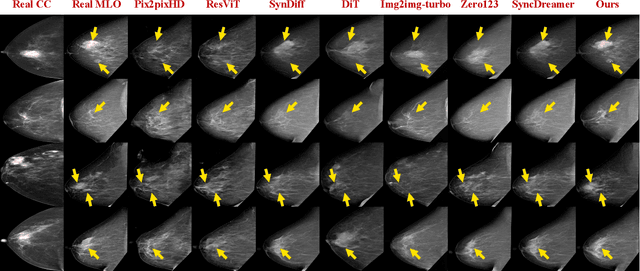
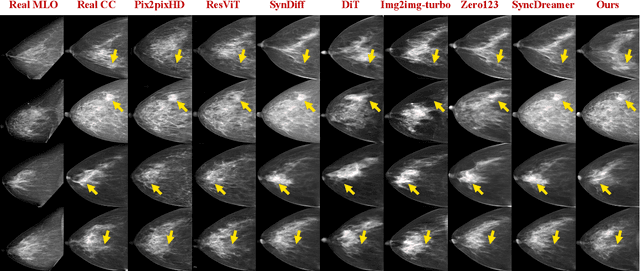
Dual-view mammography, including craniocaudal (CC) and mediolateral oblique (MLO) projections, offers complementary anatomical views crucial for breast cancer diagnosis. However, in real-world clinical workflows, one view may be missing, corrupted, or degraded due to acquisition errors or compression artifacts, limiting the effectiveness of downstream analysis. View-to-view translation can help recover missing views and improve lesion alignment. Unlike natural images, this task in mammography is highly challenging due to large non-rigid deformations and severe tissue overlap in X-ray projections, which obscure pixel-level correspondences. In this paper, we propose Column-Aware and Implicit 3D Diffusion (CA3D-Diff), a novel bidirectional mammogram view translation framework based on conditional diffusion model. To address cross-view structural misalignment, we first design a column-aware cross-attention mechanism that leverages the geometric property that anatomically corresponding regions tend to lie in similar column positions across views. A Gaussian-decayed bias is applied to emphasize local column-wise correlations while suppressing distant mismatches. Furthermore, we introduce an implicit 3D structure reconstruction module that back-projects noisy 2D latents into a coarse 3D feature volume based on breast-view projection geometry. The reconstructed 3D structure is refined and injected into the denoising UNet to guide cross-view generation with enhanced anatomical awareness. Extensive experiments demonstrate that CA3D-Diff achieves superior performance in bidirectional tasks, outperforming state-of-the-art methods in visual fidelity and structural consistency. Furthermore, the synthesized views effectively improve single-view malignancy classification in screening settings, demonstrating the practical value of our method in real-world diagnostics.
Deep Learning-Based Cross-Anatomy CT Synthesis Using Adapted nnResU-Net with Anatomical Feature Prioritized Loss
Sep 26, 2025



We present a patch-based 3D nnUNet adaptation for MR to CT and CBCT to CT image translation using the multicenter SynthRAD2025 dataset, covering head and neck (HN), thorax (TH), and abdomen (AB) regions. Our approach leverages two main network configurations: a standard UNet and a residual UNet, both adapted from nnUNet for image synthesis. The Anatomical Feature-Prioritized (AFP) loss was introduced, which compares multilayer features extracted from a compact segmentation network trained on TotalSegmentator labels, enhancing reconstruction of clinically relevant structures. Input volumes were normalized per-case using zscore normalization for MRIs, and clipping plus dataset level zscore normalization for CBCT and CT. Training used 3D patches tailored to each anatomical region without additional data augmentation. Models were trained for 1000 and 1500 epochs, with AFP fine-tuning performed for 500 epochs using a combined L1+AFP objective. During inference, overlapping patches were aggregated via mean averaging with step size of 0.3, and postprocessing included reverse zscore normalization. Both network configurations were applied across all regions, allowing consistent model design while capturing local adaptations through residual learning and AFP loss. Qualitative and quantitative evaluation revealed that residual networks combined with AFP yielded sharper reconstructions and improved anatomical fidelity, particularly for bone structures in MR to CT and lesions in CBCT to CT, while L1only networks achieved slightly better intensity-based metrics. This methodology provides a stable solution for cross modality medical image synthesis, demonstrating the effectiveness of combining the automatic nnUNet pipeline with residual learning and anatomically guided feature losses.
Continual Action Quality Assessment via Adaptive Manifold-Aligned Graph Regularization
Oct 08, 2025



Action Quality Assessment (AQA) quantifies human actions in videos, supporting applications in sports scoring, rehabilitation, and skill evaluation. A major challenge lies in the non-stationary nature of quality distributions in real-world scenarios, which limits the generalization ability of conventional methods. We introduce Continual AQA (CAQA), which equips AQA with Continual Learning (CL) capabilities to handle evolving distributions while mitigating catastrophic forgetting. Although parameter-efficient fine-tuning of pretrained models has shown promise in CL for image classification, we find it insufficient for CAQA. Our empirical and theoretical analyses reveal two insights: (i) Full-Parameter Fine-Tuning (FPFT) is necessary for effective representation learning; yet (ii) uncontrolled FPFT induces overfitting and feature manifold shift, thereby aggravating forgetting. To address this, we propose Adaptive Manifold-Aligned Graph Regularization (MAGR++), which couples backbone fine-tuning that stabilizes shallow layers while adapting deeper ones with a two-step feature rectification pipeline: a manifold projector to translate deviated historical features into the current representation space, and a graph regularizer to align local and global distributions. We construct four CAQA benchmarks from three datasets with tailored evaluation protocols and strong baselines, enabling systematic cross-dataset comparison. Extensive experiments show that MAGR++ achieves state-of-the-art performance, with average correlation gains of 3.6% offline and 12.2% online over the strongest baseline, confirming its robustness and effectiveness. Our code is available at https://github.com/ZhouKanglei/MAGRPP.
MANZANO: A Simple and Scalable Unified Multimodal Model with a Hybrid Vision Tokenizer
Sep 19, 2025Unified multimodal Large Language Models (LLMs) that can both understand and generate visual content hold immense potential. However, existing open-source models often suffer from a performance trade-off between these capabilities. We present Manzano, a simple and scalable unified framework that substantially reduces this tension by coupling a hybrid image tokenizer with a well-curated training recipe. A single shared vision encoder feeds two lightweight adapters that produce continuous embeddings for image-to-text understanding and discrete tokens for text-to-image generation within a common semantic space. A unified autoregressive LLM predicts high-level semantics in the form of text and image tokens, with an auxiliary diffusion decoder subsequently translating the image tokens into pixels. The architecture, together with a unified training recipe over understanding and generation data, enables scalable joint learning of both capabilities. Manzano achieves state-of-the-art results among unified models, and is competitive with specialist models, particularly on text-rich evaluation. Our studies show minimal task conflicts and consistent gains from scaling model size, validating our design choice of a hybrid tokenizer.
AREPAS: Anomaly Detection in Fine-Grained Anatomy with Reconstruction-Based Semantic Patch-Scoring
Sep 16, 2025Early detection of newly emerging diseases, lesion severity assessment, differentiation of medical conditions and automated screening are examples for the wide applicability and importance of anomaly detection (AD) and unsupervised segmentation in medicine. Normal fine-grained tissue variability such as present in pulmonary anatomy is a major challenge for existing generative AD methods. Here, we propose a novel generative AD approach addressing this issue. It consists of an image-to-image translation for anomaly-free reconstruction and a subsequent patch similarity scoring between observed and generated image-pairs for precise anomaly localization. We validate the new method on chest computed tomography (CT) scans for the detection and segmentation of infectious disease lesions. To assess generalizability, we evaluate the method on an ischemic stroke lesion segmentation task in T1-weighted brain MRI. Results show improved pixel-level anomaly segmentation in both chest CTs and brain MRIs, with relative DICE score improvements of +1.9% and +4.4%, respectively, compared to other state-of-the-art reconstruction-based methods.
 Add to Chrome
Add to Chrome Add to Firefox
Add to Firefox Add to Edge
Add to Edge